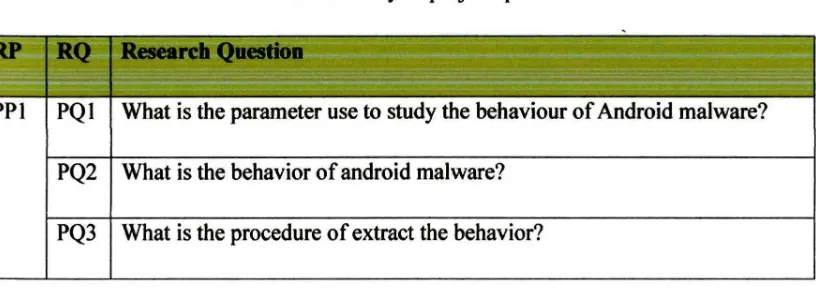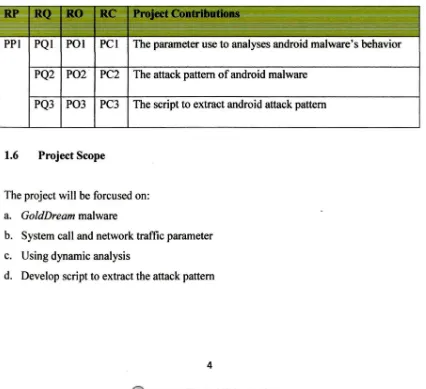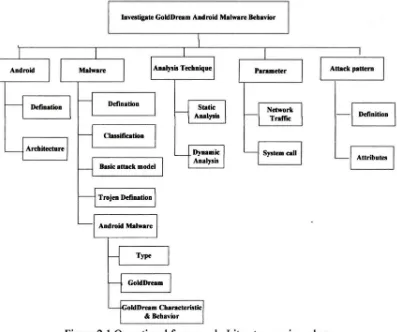BORANG PENGESAHAN STATUS TESIS
JUDUL: INVESTIGATING GOLDDREAM ANDROID MAL WARE BEHAVIOR THROUGH DYNAMIC ANALYSIS
SESI PENGAJIAN: SESI 2012/2013
Saya LOW JUN KEAT mengaku membenarkan tesis Projek Sarjana Muda ini disimpan di Perpustakaan Fakulti Teknologi Mak.lumat dan Komunikasi dengan syarat-syarat kegunaan seperti berikut:
1. Tesis dan projek adalah hakmilik Universiti Teknikal Malaysia Melaka.
2. Perpustakaan Fakulti Teknologi Maklumat clan Komunikasi dibenarkan membuat salinan untuk tujuan pengajian sahaja.
3. Perpustakaan Fakulti Teknologi Maklumat dan Komunikasi dibenarkan membuat salinan tesis ini sebagai bahan pertukaran antara institusi pengajian tinggi.
4.
**
Sila tandakan (!) SULITTERHAD
I TIDAK TERHAD
(T ANDA
i
ANGAN PENULIS)(Mengandungi maklumat yang berdarjah keselamatan atau kepentingan Malaysia seperti yang termaktub di dalam AKT A RAHSIA RASMI 1972)
(Mengandungi mak.lumat TERHAD yang telah ditentukan oleh organisasi/badan di mana
penyelidikan dijalankan)
Alamat tetap : 924, Pennatang Bendahari
13110 Penaga S.P.U DR. SITI RAHA YU SELAMA T
Nama Penyelia Pulau Pinang. Malaysia
INVESTIGATING GOLD DREAM ANDROID MAL WARE BEHAVIOR THROUGH DYNAMIC ANALYSIS
LOW JUNK.EAT
This report is submitted in partial fulfillment of the requirement for the Bachelor of Computer Science (Computer Networking)
FACULTY OF INFORMATION AND COMMUNICATION TECHNOLOGY UNIVERSITI TEKNIKAL MALAYSIA MELAKA
DECLARATION
I hereby declare this project report entitled
INVESTlGA TING GOLDDREAM ANDROID MAL WARE BEHAVIOR
THROUGH DYNAMIC ANALYSIS
is written by me and is my own effort and that no part has been plagiarized without
citations.
STUDENT
DEDICATION
This work is dedicated to my beloved family and siblings, who passed on a love of
reading and respect for education.
To my supportive friends, my supervisor and all lecturers, thank you so much for assist
ACKNOWLEDGEMENTS
Thanks the god for giving me the opportunity to complete this Final Year Project which
is titled Investigating GoldDream Android Malware Behavior Through Dynamic
Analysis.
Firstly, I would like to thanks to, my supervisor, DR. SITI RAHA YU SELAMA T for her
technical guidance and valuable time in assisting us in the accomplishing my project. I
also want to thanks to all lecturers for their cooperation during completing my fmal year
project by giving valuable information, suggestions and guidance in the compilation and
preparation of this report.
Lastly, deepest thanks and appreciation to my parents, family and friends for their
understanding, cooperation and full of support for the report completion, from the
beginning till the end of this project. Also thanks to all of my friends and everyone, that
has been contributed by supporting my work and helps myself during the final year
project progress until it is fully completed.
ABSTRACT
In recent year, the growing of Android user are become popular. Unfortunately, as
Android is getting more popular, at the same time, it cause the growing of the mobile
malware. As the malware are growth rapidly, the current problem is difficulty on
detecting and identifying the behavior of android malware. Thus, the aim of this project is
to investigate GoldDream Android malware behavior through dynamic analysis. This
project used software and hardware tool such as Wireshark for capturing network traffic,
emulator for running the android malware applications and Windows 7 operating system
as a platform in order to complete the analysis. Hence, the emulator, Wireshark and other
tools are installed in Windows 7 operating system which the experiment is executed and
data is collected. The objective of this project is to investigate the parameter of android
malware's behavior, generate the attack pattern of android malware and formulate the
procedure of extracting the attack pattern. The project are start with literature review,
analysis, design and implementation, finally is evaluate and testing. In the end of project, the general attack pattern of GoldDream malware is generated based on its basic attack
model and its attributes. Then, the GoldDream attack pattern extraction script is
ABSTRAK
Kini, kegunaan Andorid menjadi semakin popular, tetapi dalam masa yang sama ia menyebabkan penyebaran ma/ware semakin serius. Oleh sebab ma/ware menyebar dan
berevolusi dengan cepat telah menyebakan kesukaran dalam mengesan dan
mengenalpasti sifat-sifat ma/ware. Dalam projek ini, sifat GoldDream android ma/ware
akan dikenalpasti melalui analisis dinamik. Projek ini menggunakan perisian dan
perkakasan serta alatan seperti Wireshark bagi pengumpulan data trafik rangkaian,
emulator untuk memasang aplikasi ma/ware Android dan system pengoperasian Windows 7 untuk menjalankan analisis. Emulator, Wireshark dan alat-alat lain di pasang dalam sistem pengoperasian Windows? untuk mengesan dan pengumpulan data aktiviti
ma/ware Android. Objektif projek ini adalah untuk mengenalpasti parameter tingkah
laku, menjana corak serangan dan merangka prosedur mengeluarkan corak serangan.
ma/ware Android. Projek ini dimulakan dengan kajian literatur, analisis, reka bentuk dan
pelaksanaan, serta akhimya menilai dan menguji. Pada akhir projek, corak serangan umum GoldDream dihasilkan berdasarkan model serangan dan sifatnya. Seterusnya, satu
script dibangunkan bagi mengenalpasti dan menghasilkan corak seranggan GoldDream.
TABLE OF CONTENTS
CHAPTER SUBJECT PAGES
DECLARATION
DEDICATION ii
ACKNOWLEDGMENT iii
ABSTRACT iv
ABSTRAK v
TABLE OF CONTENTS vi
LIST OFT ABLES x
LIST OF FIGURES xii
1 INTRODUCTION
1.1 Project Background
1.2 Problem Statements 2
1.3 Project Questions 2
1.4 Project Objectives 3
1.5 Project Contribution 4
1.6 Scope 4
1.7 Project Significant 5
1.8 Report Organization 5
1.9 Summary 6
2 LITERATURE REVIEW
2.1 Introduction 7
2.2 Android 8
2.2.2 .t\rchitecture 8
2.3 Mal ware 9
2.3.1 Malware Definition 9
2.3.2 Malware Distribution 10
2.3.3 Malware Classification 10
2.3.4 Basic Malware Attack Model 12 2.3 .5 Trojan Horse Definition 13 2.3.6 Trojan Horse Classification 13
2.3.7 Android Malware 14
2.4 Analysis Technique 17
2.4.l Static Analysis 17
2.4.2 Dynamic Analysis 18
2.5 Parameter 18
2.5.1 Network Traffic 18
2.5.2 System Call 22
2.6 Attack Pattern 23
2.7 Summary 24
3 METHODOLOGY
3.1 Introduction 25
3.2 Project Methodology 25
3.2.1 Phase I: Literature Review 26
3.2.2 Phase II: Analysis 26
3.2.3 Phase III: Design & Implementation 26 3.2.4 Phase V: Testing & Evaluation 27 3 .3 Project Schedule & Milestones 28
3.3.l Gantt Chart 28
3.3.2 Milestones 29
3.4 Summary 29
4 DESIGN AND IMPLEMENTATION
4.1 Introduction 30
4.2
GoldDream Analysis Approach30
4.2.l
Setup Network31
4.2.2
Setup Environment33
4.2.3
Malware Activation & Data Collection34
4.2.4
Data Analysis37
4.3
GoldDream attack pattern extractionScripting Design
55
4.3.1
General Design for GoldDreamattack pattern extraction Script
55
4.3.2
GoldDream attack pattern extractionProcess Script
56
4.4
Summary60
5 TESTING AND RESULT ANALYSIS
5.1
Introduction61
5.2
Test Planning61
5.2.1
Test Organization61
5.2.2
Test Environment62
5.2.3
Test Schedule65
5.3
Test Strategy65
5.3.1
Unit Testing66
5.3.2
Integrate Testing66
5.4
Test Design66
5.4.l
Test Data Set66
5.5
Test Result67
5.5.1
Test Result for System Call67
5.5.2
Test Result for Network Traffic71
5.6
Result Analysis73
5.6.l
System Call Result Analysis73
5.6.2
Network traffic Result Analysis78
5.7.l
Capturing Phone Call Log and82
Sms Malware Activity5.7.2
Sending Information to Server85
5.7.3
General GoldDream Attack Pattern86
5.8
Summary87
6 CONCLUSION
6.1
Introduction88
6.2
Project Summarization88
6.3
Project Contribution88
6.4
Project Limitation89
6.5
Further Project89
REFERENCES
90
APPENDIX
93
5.5 Datasets summarization 67
5.6 Comparison of system call result between script
output and manual analysis for DS 1 74
5.7 Comparison of system call result between script
output and manual analysis for DS2 75
5.8 Comparison of system call result between script
output and manual analysis for DS3 76
5.9 Comparison of system call result between different Dataset 77
5.10 Comparison of network traffic result between script
output and manual analysis for DS 1 78
5.11 Comparison of network traffic result between script
output and manual analysis for DS2 79
5.12 Comparison of network traffic result between script
output and manual analysis for DS3 80
LIST OF TABLES
TABLE TITLE PAGE
1.1 Summary of problem statement 2
1.2 Summary of project questions 2
1.3 Summary of project objectives 3
1.4 Summary of project contributions 4
2.1 Malware classification and Definition 11
2.2 Trojan Horse classification and Definition 13
2.3 Android malware type and Definition 15
2.4 Description of each field in IP Header 20
2.5 Description of each field in TCP Header 21
3.1 PSM 1 Milestones 29
4.1 Collected user and devices information 48
4.2 Network traffic attributes 50
4.3 System call attributes 51
5.1 Test organization 62
5.2 Hardware Requirements 63
5.3 Software Requirements 63
5.4 Test Schedule 65
LIST OF FIGURES
FIGURE TITLE PAGE
2.1 Operational framework: Literature review phase 8
2.2 Android Architecture 9
2.3 Mal ware distribution in 2013 10
2.4 Malware classification 10
2.5 General Malware attack pattern 12
2.6 Basic Malware attack model 12
2.7 Trojan Horse classification 13
2.8 Percentage of mobile operating system infected by malware 14
2.9 Analysis technique 17
2.10 IP header 19
2.11 TCP header 19
3.1 Project Methodology 25
3.2 Project Gantt Chart 28
4.1 Analysis Approach 30
4.2 Physical design of malware analysis environment 31
4.3 Logical design of malware analysis environment 32
4.5
Process of collect system call36
4.6
Data analysis Approach37
4.7
Collected network traffic38
4.8
Content of network traffic39
4.9
Capture of phone call log40
4.10
Capture of received message content41
4.11
Location of zjphonecall.txt and zjsms.txt42
4.12
Content of zjphonecall. txt45
4.13
Content of zjsms.txt45
4.14
Process of sending user and devices information47
4.15
Collect user and devices information48
4.16
Resolve domain name to IP address48
4.17
Establish connection to server49
4.18
Process flow of capture the phone log and sms52
4.19
Basic Attack Model53
4.20
GoldDream attack Pattern54
4.21
General design for goldDream attack pattern extraction script55
4.22
Overall process of GoldDream attack pattern exn:action script56
4.23
Phone call and sms identification57
4.24
Information stealing identification58
4.25
Extraction of malicious network traffic payload59
5.1
Test environment design64
5.2 Result of capture phone call log and sms from DS 1 68
5.3 Result of capture phone call log and sms from DS 2 68
5.4 Result of capture phone call log and sms from DS 3 69
5.5 Result of send user and devices information to server from DS 1 70
5.6 Result of send user and devices information to server from DS 2 70
5.7 Result of send user and devices information to server from DS 3 71
5.8 Result of network traffic from DS 1 72
5.9 Result of network traffic from DS 2 73
5.10 Result of network traffic from DS 3 73
5.11 Example captured data 83
5.12 General format of captured data 83
5.13 Example location of store text file 84
5.14 General pattern of file location 84
5.15 Method to save captured data 84
5.16 Request url 86
5.17 General url pattern 86
CHAPTERl
INTRODUCTION
1.1 Project Background
In recent year, the growing of smart phone is become popular. There are various of operating system in smart phone such as /OS, Window, Android as well as Symbian.
Android is the most popular (40.9%) compare to Apple ios(40.5%), Blackberry (8.9%)
(Arlotta, 2013). Unfortunately, as android are getting more popular, at the same time, it
cause the growing of the mobile malware.
Malware also known as malicious software used or created by attackers to damage or
destroy computer operation, stole sensitive information and break into private computer
systems. It can be emerge as a collection of code, script, active content and embedded in
other application (McMahon, 2013).
The malware are grows rapidly, it is a need to take effectively defend against the
malware. In order to create a method to against the malware, we need to study, analysis and investigate the malware. Malware analysis is an activity in which carry out by
reverse engineering the malware and investigate on code structure, operation and
functionality (Varghese, 2011).
The goal of this project is to understand the behavior of an android malware. In addition,
Android OS is a popular environment for mobile malware. It needs to take an action to overcome it before it getting serious. However, we need to understand how it works
before we can defend it.
Therefore, this project will use dynamic analysis to analyse the malware. It will focuses on the behavior of attack, determine how and what it gets installed, how it run, what background process had been create, which port are using to communicate, who they are communicate to, etc.( Distler, 2007). In this project, the parameter such as system call and network traffic will be investigated.
1.2 Problem Statement
Malware will spread widely, rapidly, will embed in other software and some may encrypted the network traffic. This characteristic causes the difficulty to detect and identify the malware (Yen, 201 1 ). The Project Problem (PP) is summarized into Table 1.1.
Table 1. 1 Summary of problem statement
PPl Difficulty on detecting and identifying the behavior of Android malware
1.3 Project Questions
Three Project Questions (PQ) is constructed to identify the problem statement as discussed in previous section is depicted in Table 1 .2.
Table 1.2 Summary of project questions
PPl PQI What is the parameter use to study the behaviour of Android malware? PQ2 What is the behavior of android malware?
[image:18.524.62.470.556.709.2]PQl: What is the parameter use to study the behaviour of Android malware?
This project question is to analyses which parameter is suitable to use to study on the behavior of Android malware. Because of different type of malware may infect to different parameter, thus it is important to analyses which parameter should be use.
PQ2: What is the behavior of Android malware?
This project question is to study and identify which technique is suitable to use to collect the data that use to identify the behavior.
PQ3: What is the procedure of extract the behavior?
This project question is to find out how to extract the behavior and generate the attack pattern automatically.
1.4 Project Objectives
Based on the project questions formulated in previous section, appropriate project objectives (PO) are developed as follows:
Table 1.3 Summary of research objectives
PPI PQI POI To investigate the parameter of Android malware's behavior PQ2 P02 To generate the attack pattern of Android malware
PQ3 P03 To formulate the procedure of extracting the attack pattern
PO 1: To investigate the parameter of Android malware's behavior
In order to analyse the Android malware, first we must identify what parameter will be use to analyse the malware. Different type of malware may have different type of parameter to inspect.
[image:19.524.59.472.468.600.2]PO 2: To generate the attack pattern of Android malware
After determine the parameter use to analyses the malware, the next step is to collect data and analyses the data to identify the behavior in order to generate attack pattern.
POJ: To formulate the procedure of extracting the attack pattern
After generate the attack pattern of malware, then will formulate the procedure and develop a script to extract the attack pattern automatically from raw data.
1.5 Project Contributions
[image:20.524.52.478.362.751.2]The contribution of this project are summarized in Table 1.4
Table 1.4 Summary of project contributions
PPI PQI POI PCI The parameter use to analyses android malware' s behavior PQ2 P02 · PC2 The attack pattern of android malware
PQ3 P03 PC3 The script to extract android attack pattern
1.6 Project Scope
The project will be forcused on: a. GoldDream malware
b. System call and network traffic parameter c. Using dynamic analysis
1.7 Project Significant
The attack pattern of GoldDream will help developer in develop a method or software to protect the system from GoldDream malware.
1.8 Report organization
This report consist of six chapter namely Chapter I: Introduction, Chapter 2: Literature Review, Chapter 3: Methodology, Chapter 4: Design and Implementation, Chapter 5: Testing and Result Analysis and Chapter 6: Conclusion.
Chapter 1: Introduction
This chapter will discuss about introduction, project background, research problem, research question, research objective, scope, project significant and report organization.
Chapter 2: Literature Review
This chapter will explain related work of this project, such as Android, malware, analysis technique and parameter.
Chapter 3: Methodology
This chapter will explain the method use to analyse the malware and organise the sequence of project work in phase by phase.
Chapter 4: Design and Implementation
This chapter will introduce the software and hardware use in this project, environment setup, implementation of malware as well as the data collected.
Chapter 5: Testing and Result Analysis
This chapter will analyse the collected data and carry out the scripting proposed to support the evidence.
Chapter 6: Conclusion
This chapter will concludes and discussed the finding, limitations, contribution and the future work of the project.
1.9 Summary
CHAPTER2
LITERATURE REVIEW
2.1 Introduction
In chapter I , the problem statement, questions and objective of the projects are clearly identified. For this chapter, the main topics are literature review will be discussed. The aim of this chapter is to review several issues related with this project, such as Android, malware, analysis technique and parameter as depicted in Figure 2.1 .
Android
Defmation
Architecture
Investigate GoldDre11m Alldroid Malware Bellavior
Malware Def"mation Clusif"1e11tioa Allalysis Techniqae Static Aaalysis
Buie attack model
Dyumic
Analysis
Trojen Def"mation
Android Malware
Type
ldDre11m Characteristic
& Bellavior
Parameter
Network Traffic
System call
Attack pattern
[image:23.524.62.459.351.683.2]-I
DefinitionI
Figure 2.1 Operational framework: Literature review phase
Figure 2.1 shows the topic will be discussed in the following sections. Further information on Android, malware, analysis technique and system parameter issues are gathered. During the Literature Review phase, the relevant literature in journals, articles, thesis, technical reports, books, websites and other academic sources are reviewed. The 5 main issues to discuss in literature review is Android, malware, analyses technique, system parameter and attack pattern.
2.2 Android
In this section, the definition and the architecture of android is discussed.
2.2.1 Definition
Android is a Linux-based operating system (Katsarakis, 2012) that mainly designed for touch screen mobile device such as tablet and smart phone. Android, Inc. was the first who start to develop Android and it is financially backed by Google, but in 2005 it is bough by Google (Elgin and Ben, 2005). Android is open source and Google release the code under the Apache License in september 2008 (Katsarakis, 2012).
2.2.2 Architecture



